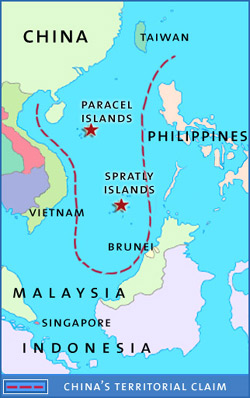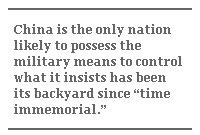All at Sea Over Resources in East Asia
All at Sea Over Resources in East Asia

in waters off the Paracel Islands, while fishermen skirmish in South China Sea
SINGAPORE: Given the generally peaceful state of the South China Sea for the past decade, it is easy to assume that at least one potential flashpoint in Asia has been defused. But recent skirmishes in which Vietnamese fishermen were killed or wounded by Chinese gunboats, followed by the hurried trip to Beijing by Hanoi diplomats, are a reminder that the contest for these waters and their bounty is far from settled.
Apart from the divided Korean peninsula and periodic tension in the Taiwan Strait, the South China Sea remains one of the most serious security concerns in East Asia. Since 1995, when China’s policy of “creeping assertiveness” – demonstrated by its secret construction of a base on Mischief Reef off the coast of the Philippines – alarmed Southeast Asia, tensions have cooled. Beijing’s southern neighbors enjoy a mutually beneficial relationship thriving on China’s explosive economic growth. Yet none of the complex territorial and jurisdictional disputes in the South China Sea have been resolved. Nor has any mechanism been established to prevent or manage conflicts. Holding fast to their respective positions, the claimant states have not even agreed to discuss the sovereignty of contested islands. Rather, all sides cross their fingers and put their faith in declarations of goodwill.
Should the political climate sour, however, the same issues that led to violence in the past could rapidly resurface. Cooperative arrangements are urgently needed, not only to preempt future armed clashes, but also to prevent the deterioration of the South China Sea through over-fishing, environmental assault and general lawlessness.

Tensions in the South China Sea rose appreciably at the end of the Cold War, when governments had the time and resources to devote to strengthening long-held claims. Claimants sought new geographical features to occupy and reinforced existing outposts with troops or commercial activities. The discovery of substantial oil and gas deposits by countries on the periphery of the semi-enclosed sea raised the stakes by encouraging the belief that a hydrocarbon bonanza may lie beneath the troubled waters.
Six countries claim all or part of the Spratly Islands, a series of remote and barren islets, rocks and submerged reefs, banks and shoals in the south: China, Taiwan, Vietnam, the Philippines, Malaysia and Brunei. All but the tiny sultanate of Brunei maintain military garrisons in the archipelago, some equipped with sophisticated communications equipment, landing strips and weaponry. The Paracel Islands in the northwest are occupied by China alone, since it long ago forcibly ejected its only rival claimant, Vietnam.

Beijing’s claim, as the most expansive and still undefined, causes special concern, and China is the only nation likely to possess the military means to control what it insists has been its backyard since “time immemorial.” Chinese maps show a broken U-shaped line, which Beijing declines to explain, enclosing almost all the 3.5 million square kilometers of the South China Sea. Analysts are undecided whether China regards everything inside the line as internal waters or merely uses the crude marking to lay claim to scattered outcrops and their adjacent waters.
The multifaceted disputes are of interest to many nations, including the major powers, because they could affect freedom of navigation through a globally strategic waterway. Sea lines of communication linking the Indian Ocean and East Asia traverse the area, accounting for more than a quarter of the world’s trade, including 70 percent of Japan’s energy needs and 65 percent of China’s.
Incensed by China’s intrusion onto Mischief Reef, some Southeast Asian officials in the late 1990s wanted to make the South China Sea a litmus test of Beijing’s long-term intentions towards Southeast Asia. But through skillful diplomacy since labeled as its “charm offensive,” Beijing has persuaded Southeast Asian governments that its priority is economic development and that they, too, can share the benefits. Those benefits, not coincidentally, extend to all 10 members of the Association of Southeast Asian Nations and not just the four members who are South China Sea claimants. Among other things, ASEAN signed on to a free-trade agreement offered by China, to be implemented as early as 2010.
ASEAN pushed China for a code of conduct in the South China Sea, but settled for less. In the Declaration on the Conduct of Parties in the South China Sea, signed in 2002, the parties reaffirmed their commitment to freedom of navigation and over-flight, pledged to resolve territorial disagreements peacefully and promised to exercise restraint in activities that could spark conflict, such as occupying uninhabited features.

Southeast Asian officials, pleased about overall relations with a booming China, have attributed reduced tensions in the area to the declaration. They point to apparent progress: China, the Philippines and Vietnam agreed in 2005 to their state-owned oil companies conducting a joint seismic survey in a vast swathe of the South China Sea. The officials have chosen to overlook the obvious holes in the declaration – that it is a political statement and not a legally binding treaty, that it does not specify the geographical scope because Beijing objected to the inclusion of the Paracels and, at best, that it is an interim step.
Taiwan exposed another gap in 2004, when it erected what it called “a simple bird-watching stand” in the Spratlys, denounced by Vietnam as an “act of land-grabbing expansion.” ASEAN regards Taiwan, which occupies the largest island in the group while not signatory to the pact, as part of China.
Recent events offer evidence that the document provides little conflict management, much less resolution, failing to prevent clashes over fishing, oil and gas exploration, and military expansion on already-occupied points.
In June, British giant BP halted work on a site off the southern Vietnamese coast due to the jurisdictional dispute. BP, ConocoPhillips of the US and state-owned Vietnam National Oil and Gas Group are building a pipeline to exploit offshore fields already producing gas. After Chinese Foreign Ministry criticism in April, BP said it had suspended seismic surveying on Block 5.2, about 370 kilometers offshore, between Vietnam and the Spratlys, to give the two governments a chance to “resolve the issue.” The delay does not affect the $2 billion project, BP explained, since it had not expected to bring Block 5.2 or neighboring Block 5.3 on stream for “some years.”
The early July shootout that killed yet another Vietnamese fisherman followed a hostile encounter in April, when the Chinese navy detained four Vietnamese fishing boats operating near the Spratlys, releasing the crews only after they paid fines.

Such skirmishes draw attention to how countries making use of the South China Sea neglect international legal obligations to preserve a valuable and delicate marine environment. For now, near anarchy prevails. Experts warn that the entire ecosystem is at the point of crisis, with the waters heavily polluted, reefs and mangroves severely degraded and fishing stocks depleted. Terrorist, drug-trafficking and smuggling routes run through and around the sea, largely unchecked.
Functional cooperative arrangements are urgently needed, which could even involve joint development. They cannot wait for the untangling of irreconcilable sovereignty claims. Participants should agree to cooperate on a “without prejudice” basis, meaning their claims would be frozen temporarily while they collaborate to prevent renewed confrontation and protect a rapidly depreciating asset.
Barry Wain, writer-in-residence at the Institute of Southeast Asian Studies in Singapore, is a former editor of the Asian Wall Street Journal.